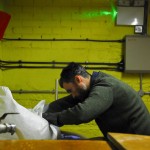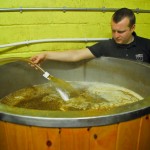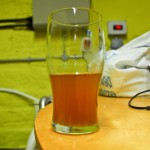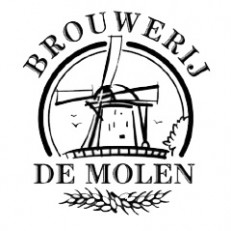
– Saison Liaison – Part 2 / By William France
Last Thursday we had the pleasure of launching our collaborative birthday beer, “Anniversary: Saison DuPort”, a traditional farmhouse ale, dangerously drinkable at 6%. Collaborating with some of the countries most progressive brewers the temptation is to go for hops, hops and more hops, we decided to go for traditional and subtle instead, staying pretty true to style and letting the yeast do the talking.
So what’s in store for the Saison now? …..It will surface at Port Street a few times before the year is out, on keg & cask, please keep an eye out for it.
Also, the word on the street is that it’s going to be in some of the UK’s finest purveyors of the malt based beverage that is beer.The Sparrow in Bradford, Cask Pub & Kitchen in London, Mr Foley’s in Leeds, The Evening Star in Brighton and the Free Trade Inn in Newcastle have all said they would take our creation. These amazing places share our love of beer and we are so proud to have it winging it’s way to them.
The beer is also being bottled and aged, allowing the yeast to carry on doing it’s thing, we’ll maybe crack some of these on our next anniversary.
Big thanks go first of all to the brewers Summer Wine Brewery, Red Willow, Quantum, Magic Rock and Darkstar.
Not only but also, our pumpclip design and production by Alex Humphreys (Illustration), Kunstkammer (Graphic Design), Savwo (Print and ink dribbling).
Word by William France

– Saison Liaison by Jonathan Heyes
Who would’ve thunk it? It’s nye on 12 months since PSBH came in to being, it’s been an exciting year in lots of ways, not least the opportunity it’s given us to work with some fantastic brewers. Occasionally they’ve been kind enough to let us come down to the brewery and ‘help out’, this usually involves us getting in their way, offering useless suggestions, doing any menial tasks thrown at us but hopefully learning a lot along the way.
So as a celebration of our first year we decided to put together a little brew day of our own, lacking in a brewery as we are, we asked Andy and James at Summer Wine if they’d be prepared to host, we invited some of our favourite brewers down to lend a hand, Toby from Red Willow, Jay from Quantum, Mark from Darkstar, Magic Rock and of course some of us. In the weeks running up to the brew day a flurry of emails were exchanged discussing styles, methods, malt, hops, yeast strains and the like, an agreement was struck that it should be a Saison, one of a few emergent styles during our first year of business. Maybe we’d throw in a few spices here and there but keep it pretty classic.
Brewday finally arrived and we made our way at ungodly o’ clock to Honley via Huddersfield on a beautiful crisp, cold winter’s morning and were treated to a hazy, orange bloom of a sunset creeping reluctantly up over the Pennines. First things first on arrival a pre brew brew, which gave us the chance to have a peruse of the malts and hops to be used in the brew. We settled on a mixture of pale, caramalt, wheat and a little crystal rye to add a subtle spice and colour to the wort. Hops would be a mixture of more subtle euro-style hops including Aramis, Saaz, Liberty and Sterling just enough to augment the spice character of the yeast, which was provided by Mark from Darkstar, who alas couldn’t make the trip up to join us, so his yeast had to stand in for him.
The brew day continued pretty smoothly with most of the brewers standing around drinking cups of tea issuing commands to us lower caste brew monkeys. A fantastic lunch was laid on by Andy from SWB and we got down to the really important stuff, naming the beer, this is where we started to hit a few speed bumps. We spent most of the rest of the day in heated debate, my own favourite suggestion I’ve been reduced to using for this humble blog, I’m sure you’ll agree it’s clearly a stroke of genius, the others were less convinced, not that I’m bitter about it. Eventually we settled on just calling it ‘Anniversary’, hopefully the first of a series, with the subtitle of Saison DuPort, thanks to Rich Magic Rock for coming in with a last minute blinder.
Anyway I’ve prattled on quite long enough, we’ll be launching the beer on Thursday 2nd February as part of a Birthday Party we’ll be having, you’re all invited, so come along and have a little try.
Words by J. Heyes / Pictures by J. Krause

– 2011 and beyond / by William France
Where can I really start as I look back over the last year. It was a massive journey for everyone at PSBH; staff, Jonny, customers & everyone in-between. That sounds like an intro to a ‘This is Your Life’ thank you speech haha. The main reason for writing this is to review where I thought beer was at last year and where I believe it is heading.
I think last year was one of the most important years for British beer culture, not only did a handful of amazing new bars open, but people’s drinking habits were beginning to take a massive shift.
Early on in the year we visited the Winter Ales Festival in Manchester, sampling the delights & horrors of some of the ales being produced in this country. I wont go into the bad ones as I would rather focus on the good. One example was the crowd gathering around a certain pump. This pump was dispensing a new IPA from a brewery in Honley, Summerwine. This beer was called Diablo and as we drank our halves we chatted to some of the most important people in the North West’s beer scene. Almost exactly a year on from that point, this IPA by Summerwine graces our bar but on keg not cask. That’s how fast last year’s “craft” beer scene was moving.
This neatly brings me on to talk about beer trends of 2011. I think IPA was one of the biggest in the commercial sense, this almost lost abbreviation was on the tip of everyone’s tongue, as well as in the fermenters of most brewers in many forms.
Traditional British IPAs, Black IPAs, Rye PAs, Double IPAs, IRAs… the list is massive. IPA is such a subjective style, no one alive knows what an original IPA actually tasted like, so every form is a guess and every brew a homage. A lot of the best for me were heavily influenced by craft brewing in America; hop forward, strong and dangerously drinkable. There was however a simmering undertone of a lean to more traditional hop usage, Thornbridge Seaforth springs to mind with the hops Target and Progress being used to great affect. Darkstar’s Green Hopped IPA also used target masterfully as a finishing hop.
The next big one, obviously is keg which has become the driving force of the craft scene in Britain. Whilst Camra may not agree, a lot of exciting things have gone under pressure this year and have brought many new drinkers away from mass produced beer to handmade excellent products. Whether it be key keg, steel or corny.
I will always love cask conditioned beer, but I will also always love keg. Things have changed and I believe all methods of dispense should be embraced and enjoyed by beer lovers.
Now onto Hop trends. This is pretty easy, anything big and American continued to grace our beers. Citra, Centennial, Columbus, Cascade, Simcoe, Amarillo… this list could go on. These have surfaced in many beers and even the big guys are taking notice. However, as these hops started to run out people started using alternative varieties. Nelson Sauvin use has been increasing over the last few years, for all the right reasons, and along with it’s lesser know cousins Motueka, Pacifica and so on, they are helping to bring more interesting flavours to our beer. The latter end of the year brought us beers with Aussie hops. Stella & Galaxy for me have become the stars of 2011, packing an almighty punch into lower gravity pale ales.
So what does 2012 have to offer?
I think this year is going to be even more important than the last as the thirst for new and exciting beers grows stronger. I see the top craft breweries going wild with crazy, unheard of styles that will push the envelope further forward.
Hops this year are going to be thin on the ground, especially the big C Americas. This will push brewers to be more imaginative with what they can get hold of Double Fuggles IPA? Stella and Galaxy are still in abundance so expect more great usage of them. The rise again of noble hops is going to be more widespread with strains coming from the U.S. such as Sterling & Liberty. A few more NZ strains are on these shores too, Green Bullet & Pacific Gem being the most notable.
People working together is going to be massive in 2012 too. We kicked off the year with the ultimate meeting of minds, brewing minds that is, with Darkstar, Quantum, Magic Rock, Red Willow, Summerwine & ourselves brewing a beer together. I think people working together because they love something is always a good thing. The Venus project is another example with brewsters collaborating together to produce a series of one off beers. What a great idea!
A few breweries have caught my eye too. Quantum is going from strength to strength and Tempest are my ones to watch along with the Bristol Beer Factory. The Tap East micro brewery also sounds very interesting although anything made in London is like gold dust now with the likes of The Kernel, Brodies & Camden making excellent beers. I’m keeping my beady eye on Darkstar too. For me, these guys sum up the best in British brewing. Traditional, revolutionary, trend setting alchemy at its best. Just check out their website and look at the first three specials of this year and then you will know where I am coming from.
But it’s not just the UK that excites… Small artisanal breweries are popping up all over the world; Japan now has a flourishing scene and Denmark has Mikkeller, pushing brewing to the next level. Mikkel from Mikkeller is definitely searching to make liquid gold and he is not far off. As I write this Emelisse has dropped into our cellar, another one to watch out for in 2012 from Holland, along with De Molen. All over Europe it’s going brewing mad, Norway is another example with the excellent Nogne O. I have heard rumours of stuff kicking off in Cataluya and even northern France too.
What I’m trying to say is there has never been a better time for beer lovers than right now, so get yourself into a pub and drink something new and exciting, there is enough of it.
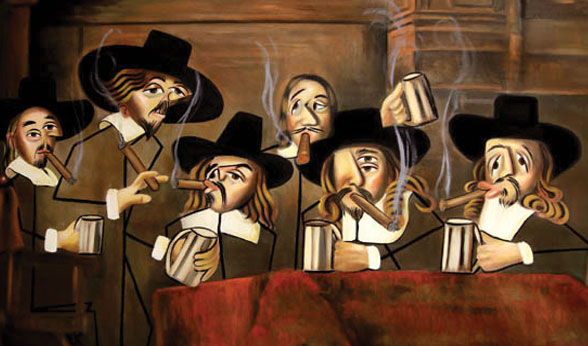
– Dutch Masters / By Jon Clarke
Hands up who can name some Dutch breweries and beers. Heineken? Check. Grolsch and Amstel? Check. La Trappe? Probably. De Molen? If you are reading this – almost certainly. And then?
Today the Netherlands is the home to some of the best beer brewed in Europe, produced by an increasing number of innovative micro brewers and beer firms (who either borrow another brewery or contract out their beers). But, to quote Michael Cain, “not many people know that”. First, a little bit of history.
Sandwiched between Belgium and Germany you might think that the Netherlands may have a long history as a centre of traditional and quality brewing. In fact it’s brewing history in the second half of the 20th Century resembles most closely that of the USA. Thus by about 1980 the Dutch brewing industry was reduced to one giant firm (Heineken – which also owns the Amstel brands) and less than 20 independent breweries, all making large quantities of adjunct ridden industrial pilsner and little else.
There were perhaps two glimmers of light in the general gloom. In the south of the country the monastery at Koningshoeven was making what are now branded as La Trappe beers and there remained the annual Bokbier tradition of strong dark autumnal beers (of which a bit more later). However, the worldwide brewing revolution didn’t pass the country by and from about 1980 onwards a trickle of microbrewers opened up. Unfortunately many of these produced wannabe Belgian-style beers which rarely matched the originals in either quality or finesse. Post production quality control left a lot to be desired as well.
Fast forward to 2011 and the scene is rather different. Heineken still dominates the market of course, and the number of independent family brewers has continued to decline. Most of the first wave micros have departed the scene, too. However there are now almost 130 breweries and beer firms, many of which are producing increasingly impressive beers in a whole range of styles. One word of warning though – in common with every country that has a burgeoning micro brewing scene, there are a fair few breweries making resoundingly dull beer; and quality control can still be an issue even for some breweries that have now been around long enough to know better. With that proviso here are a few breweries whose products are worth seeking out:
De Molen – based in Bodegraven between Leiden and Utrecht, “The Mill” is based under a windmill sited next to a canal. Just how Dutch is that? Menno Olivier is the head brewer and his beers already feature at PSBH. The best beers are the imperial stouts and big IPAs. The first imperial stout from De Molen was Rasputin (10.7%) and this, along with the wonderful Tsarina Esra imperial porter (11%), remain De Molen’s signature beers.
Emelisse – in the far south, the Grand Café Emelisse has emerged as one of the best new Dutch brewers in the past few years. New beers flow thick and fast and all are of the highest quality. The draft Black IPA (8%) was one of the highlights of the foreign beer bar at the 2011 Great British Beer Festival. Espresso Stout (8%) is superbly accomplished, as is the Imperial Stout (11%) and the recent Blond (6.8% and laden with New Zealand hops). Barrel aged imperial stouts and barley wines are also increasingly seen along with excellent Double and Triple IPAs.
De Schans – one of the older established micros, based at Uithoorn near Schipol airport since 1997. Guus Roijen has built an enviable reputation for the consistency of his beers and in the past couple of years has started to expand his range with several new and experimental offerings. The hoppy, spicy Saison (7%) has long been, and remains, a personal favourite Dutch beer. The Triple (8%) has been revamped and is now hopped only with Nelson Sauvin, as is the new Saison Ambree (7%) Also check out the Imperial Stout (8.5%) and the contract brewed Van Vollenhoven’s Extra Stout (7%).
De Eem – based in Amersfoort, Ruud van Moorst has been borrowing other brewer’s kit to make his excellent beers since 2006. Notable are the single hop IPAs – the oddly named Rosebud (6.7%) is hopped with Centennial, while Chinook (7.3%) and Warrior (4.6%) speak for themselves.
Ramses – another beer firm making an exceptional range of beers. Antenne Tripel (9%) includes local honey to give an aromatic nose while the generous use of American hops gives a firm, bitter base. Shire Stout (8.4%) is a complex wonder with vanilla, coffee and juniper berries in the mix, while Hop is a big 6.5% single hopped IPA using Pacific Gem hops from New Zealand. Others in the wide and impressive range include Den Dorstige Tiger, another big 6.6% IPA and Mamba Porter (6.4%) described as an American Porter with Amarillo, Chinook and Crystal hops in the grist.
Jopen – for many years Jopen commissioned their beers from the Proef Brewery in Belgium but last year opened the Jopenkerk in Haarlem – a hugely impressive conversion of an old church building into a gleaming state of the art brew pub. Among the newer beers are Trinitas Tripel (9%), a spicy and hoppy interpretation of the style (one of the best tripels made in the Netherlands in my opinion), and the mighty Ongelovige Thomas, described as an “imperial quadruple”. This 11% monster is more a triple IPA as it comes with huge hop character from the use of Simcoe, Chinook and Cascade hops
And this is just the tip of the iceberg. There’s really no space to more than name check other rising stars such as De Prael, Duits & Lauret, Praght, Christoffel (check out the hoppy 8.7% Nobel) and Pelgrim (whose draft Amarillo Tripel is one of my beers of the year).
Finally – a quick word about Bokbiers. Almost every Dutch brewer makes at least one of these dark, strong (minimum 6.5%) autumn beers, traditionally launched every October. A good place to try them is the annual Bokbier Festival, held on the last weekend of October at the Beurs van Berlage – on the Damrak right in the middle of Amsterdam and this year featured no fewer than 75 Dutch bokbiers. As ever it was something of a mixed bag but for me there seemed to be a steep change in overall quality this year – hopefully reflecting the great strides being made in the wider Dutch brewing scene, ironically though one of the stars was brewed by a Brit. Steve Gammage has been in the Netherlands for about 30 years but is now making some stunning stuff at Brouwerij Rodenburg. His Bronkhorster Dubbelbock, generously hopped with Cascade, Sovereign and Nelson Sauvin was a perfect marriage of traditional beer style with new wave brewing.
So there you go. The Dutch beer scene – one of the rising stars but one of the best kept secrets in European brewing. Proost!
Words by John Clarke / Chariman of South Manchester CAMRA and Editor of Opening Times






